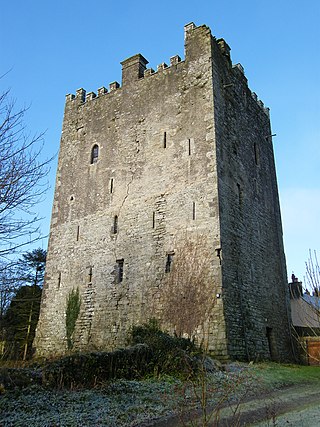
A sheela na gig is a figurative carving of a naked woman displaying an exaggerated vulva. These carvings, from the Middle Ages, are architectural grotesques found throughout most of Europe on cathedrals, castles, and other buildings.

Shanballymore is a small village in County Cork, Ireland. It neighbours the towns of Doneraile, Kildorrery and Castletownroche, and is off the main route from Mallow to Mitchelstown. Shanballymore is part of the Cork East Dáil constituency.

Cahersiveen, sometimes Cahirciveen, is a town in the far south-west of Ireland, in County Kerry. As at 2022 it had a population of 1,297.

Fethard is a small town in County Tipperary, Ireland. Dating to the Norman invasion of Ireland, the town's walls were first laid-out in the 13th century, with some sections of these defensive fortifications surviving today.

Aughagower or Aghagower is a small village in rural County Mayo in western Ireland. It is 6 km south-east of Westport. Aughagower has around forty houses, a pub and a shop, with a clear view of Croagh Patrick from Reek View. It is also at the centre of Aghagower civil parish which covers an area of 86.1 square miles. The village is known for its links to Saint Patrick and Tóchar Phádraig, the pilgrimage route from Ballintubber Abbey to Croagh Patrick.

Ballaghmore is a small village located on the western side of County Laois, Ireland, southwest of Portlaoise. It is approximately 7 kilometres (4 mi) east of Roscrea. The village is in the civil parish of Kyle in the historic barony of Clandonagh.

"Sheela-Na-Gig" is a song by English alternative rock singer-songwriter PJ Harvey, written solely by Harvey. The song was released as the second single from her debut studio album, Dry, in February 1992. The single was the second, and final, single from Dry and only single from the album to enter the charts in both the United Kingdom and United States. It peaked at number 9 on the Billboard Modern Rock Tracks chart, becoming one of Harvey’s highest charting songs in the U.S. An accompanying music video, directed by Maria Mochnacz, was released alongside the single.
Kiltinan Castle is a castle near Fethard, County Tipperary, Ireland.

Scregg House is an 18th-century house in the townland of Scregg, south of Knockcroghery, in County Roscommon, Ireland. It was built in 1769 and occupied by J.E. Kelly in 1837 and Eliza Kelly in the 1850s. In a sale rental document of 1856, the house is described as a "respectable mansion, 3 stories high with basement and attic stories and a view of the Shannon River". Occupied in 1906 by the representatives of Henry Potts, the house is extant but no longer occupied. It is included on Roscommon County Council's Record of Protected Structures. Between 2007 and 2009, the Irish Georgian Society provided grant funding for repairs to the house's roof and windows.
Redwood is a townland in the historical Barony of Ormond Lower, County Tipperary, Ireland. It is also an electoral district in the Dáil constituency of Offaly having previously been part of the Tipperary North Dáil constituency.

Roscommon County Museum is a museum dedicated to the history of County Roscommon, and is run by the County Roscommon Historical and Archaeological Society. The museum is housed in a former Presbyterian church in Roscommon town.

The vagina and vulva have been depicted from prehistory onwards. Visual art forms representing the female genitals encompass two-dimensional and three-dimensional. As long ago as 35,000 years ago, people sculpted Venus figurines that exaggerated the abdomen, hips, breasts, thighs, or vulva.

The townland of Doon in the civil parish of Tomregan is in the electoral district of Ballyconnell. It is also situated in the barony of Tullyhaw.

Liathmore Churches are two medieval churches forming a National Monument in County Tipperary, Ireland.

Castlemagner is a village, townland and civil parish in the Duhallow area of north-west County Cork, Ireland. Castlemagner is within the Cork North-West.

The Coolaghmore sheela na gig was discovered in 1975 at the 13th century church at Coolaghmore, County Kilkenny, Ireland during clearance work at the graveyard. It is thought to have been buried in the 19th century. According to local sources, it had been found in a well in Kyle previously and been brought to Coolaghmore Graveyard. It was then donated to Rothe House Museum via Kilkenny Archaeological Society where it is on display in a bricked up window in the shop of the first of the three houses since about 2012. The sites and monuments records number is KK019-026170.

The Liathmore Sheela-na-gig is a carving on the northern doorway at the larger church ruin at Liathmore monastic site in the townland of Leigh, County Tipperary in Ireland. The Sites and Monuments Record number for the sheela na gig carving is TN042-055004.

The Fethard Abbey Sheela-na-gig is located in a wall on the grounds of the former Augustinian Abbey in Fethard. Its National Sites and Monuments number is TS070-040030. One of its earliest mentions is in the School Collection which also includes a black and white photograph.

St Gobnait's well is a religious complex built on the site of a 6th or 7th century nunnery near Ballyvourney, County Cork, Ireland. Consisting of a holy well, two churches and a graveyard, it dates to the Middle Ages. The site is associated with the 8th century saint Gobnait, and today it is a place of veneration and pilgrimage, where people walk around the site reciting the rosary to pray for the dying and dead. Eleventh February and Whit Sunday are the two central dates of gathering.
Project Sheela is an Irish contemporary street art initiative that emerged on International Women's Day in 2020, capturing attention both online and offline. The project, spearheaded by two anonymous Dublin-based artists, celebrates themes of women's rights, female sexuality and empowerment, through the deployment of Sheela-na-gig sculptures across Dublin. The project returns each year for International Women's Day, focusing on sites significant to women's rights.


















